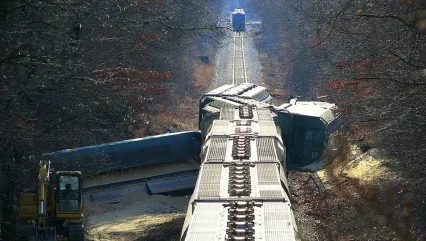
The findings of a study into the train collisions that left carriages jammed inside a tunnel portal near Salisbury in England, in 2021, have been published by the UK’s Rail Accident Investigation Branch (RAIB).
Near Salisbury, in south England, two busy railway
lines come together in a junction immediately outside Fisherton Tunnels east portal. On the early evening of 31 October 2021, on that track layout funnelling into the 405m-long tunnel, a combination of factors but primarily wet leaves and late braking contributed to two trains travelling westbound, on the different lines, to crash together with some carriages derailing, and their momentum taking them partly into the tunnel, jamming in the tunnel mouth.
The accident required hospital treatment for 13 passengers and one member of the railway staff. Another 10 passengers were treated at the scene. The trains were transporting a combined total of 197 passengers and five members of staff.
The trains and rail infrastructure of tracks, signalling and tunnel area were significantly damaged.
Factors in the accident were wet leaves on the tracks and the driver of one train didn’t apply brakes early enough on the approach to the signal protecting the junction, given the low level of adhesion, according to the findings of the UK’s Rail Accident Investigation Branch (RAIB), part of the Department for Transport (DfT).
In its report, published October 2023, RAIB says the low wheel/rail adhesion from
leaf contamination in the local area of the Salisbury Tunnel Junction was made worse by rain drizzle on the railhead a short time before the collision of the trains travelling in the same direction.
It adds that the braking systems on train IL53 were unable to mitigate this very low adhesion. That train passed a red signal and collided at 52 mph (84km/h) with the other westbound train, IF30, travelling at 20mph (32km/h) the maximum permitted on the sharp curve of its line as the tracks came together.
The problem with the presence of leaves on the lines was made worse that day by weather, besides the drizzling rain, says RAIB. It adds that problems with leaves was not new it was not effectively managed either proactively or reactively by the railtrack owner and operator, Network Rail. The accident investigator further adds that the area had increased density of vegetation it was overgrown again due to ineffective management.
While train IL53 collided with the slower train, also going westbound, it was fortunate not to have encountered a train coming out of the tunnel toward it and crossing its path at the junction which a train had done less than a minute earlier. This, adds RAIBs report, would have been potentially a far more serious collision.
The IL53 was on the main line, where the approach to the junction steps the train speed down from 90mph (145km/h) to 50mph (80km/h) about 700m before where the lines meet.
In assigning weight of cause, RAIB indicates that a combination of factors are understood to have led to the collision and it expresses that view through language including probable and possible. Where it uses the term underlying it, says, it is indicating the causation has factors associated with underlying management arrangements or organisational issues.
Given those reporting parameters, its investigation found that:
A probable underlying factor was that Network Rail’s Wessex route did not effectively manage the risks of low adhesion associated with the leaf fall season.
A further possible underlying factor was that train. operator of IL53, South Western Railway, not effectively preparing it drivers for assessing and reporting low adhesion conditions.
The report notes that both Network Rail and South Western Railway have each changed and improved training and procedures for dealing with wheel/rail adhesion management and operations. They have also jointly updated their annual working arrangements to deal with higher risk locations of rail lines.
Additionally, from its investigation RAIB also made two safety observations about train internal structure, arising from signalling systems and risk.
Considering revised design criteria for the Train Protection and Warning System, and the assessment of signal overrun risk and how this accounts for high risk of low adhesion sites, the RAIB pointed to two safety issues relating to the severity of the consequences: loss of space in the drivers cab; and, jamming of internal doors in carriages, obstructing evacuation.
Railway network layouts are long established.
The investigation and report did not look at recommendations of infrastructure design or re-design for safety risk management on suitability or possibilities not siting rail track junctions quite so close to tunnel portals.






